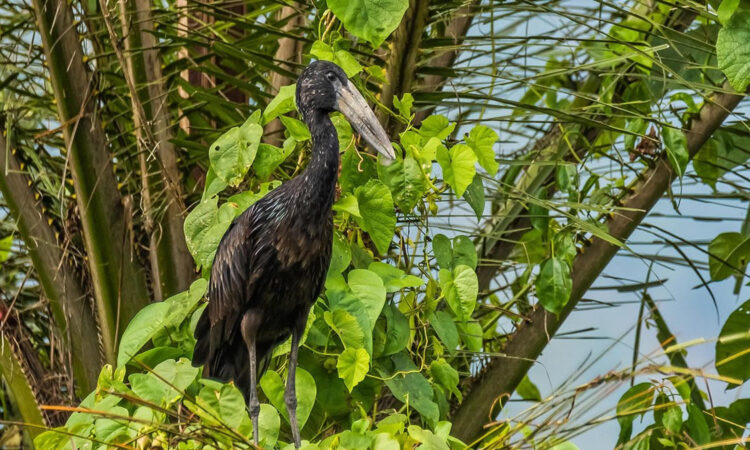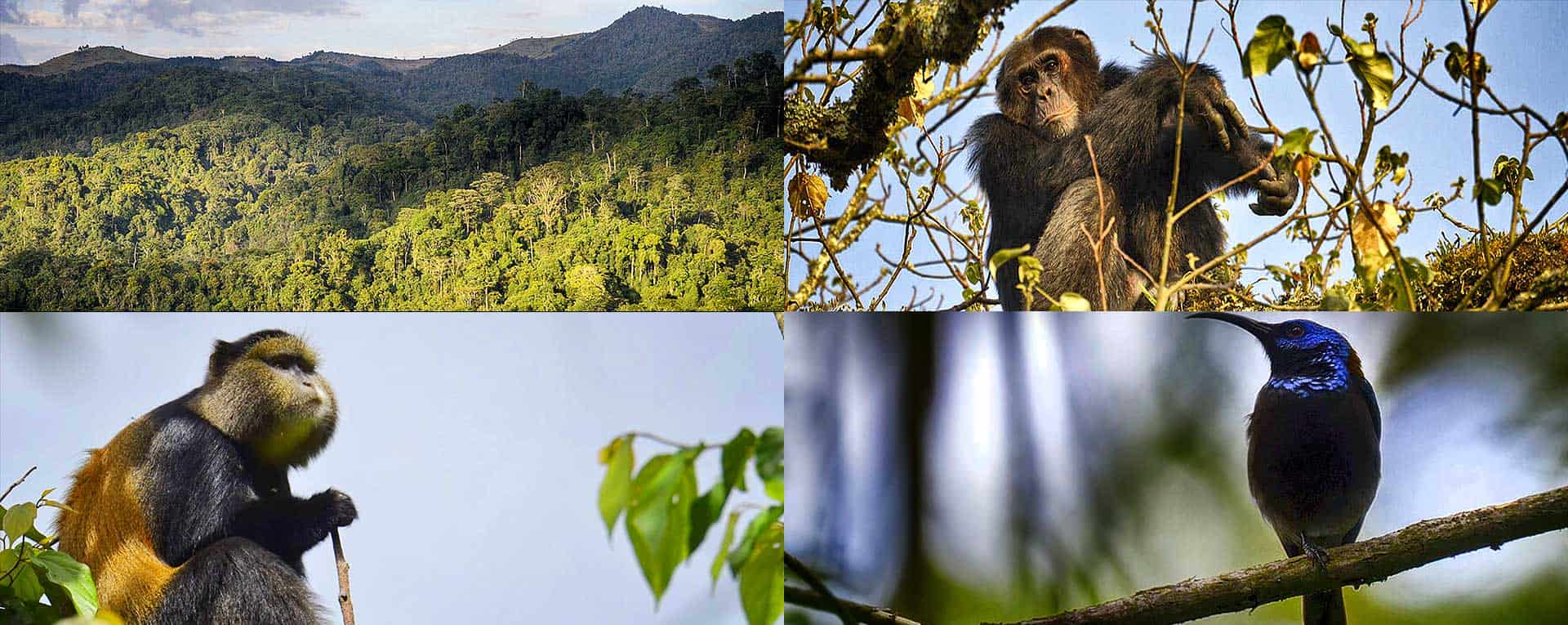
Wildlife in Gishwati-Mukura national park
Wildlife in Gishwati-Mukura national park : Gishwati-Mukura national park is located in the western province of Rwanda situated in Rutsiro district and neighbor’s four districts such as Mushonyi, Kigeyo, Nyabirasi and Ruhango. The park covers an area of approximately 34 square kilometers, the park was later a forest reserve and was formed by joining Gishwati forest reserve and Mukura forest reserve under the low passes by the government of Rwanda in 2015 with the aim to protect a large number of biodiversity and boasting the tourism industry. Gishwati-Mukura national park is Rwandan new national park famously known for hosting a large a variety of primates, mammal, and amphibians as well as reptiles species.
Gishwati-Mukura national park sits at an altitude of about 2000-3000 meters above the sea level and covers some parts of the Congo Nile Divide forest including Mukura forest reserve, also stretches up to Nyungwe forest national park and the neighboring Kibira national park in Burundi
Gishwati-Mukura is a home to a wide range of tree and shrubs species with over 84 recorded including numerous indigenous hardwoods and bamboo. The park known for hosting a wide range of fauna can be found within the forest this includes four species of primates such as 20 recorded Eastern chimpanzee, and golden monkeys, blue and white colobus, and L’Hoest’s monkeys. Other mammals that makes the park their habitat include the red river hog, the black front duiker, the southern tree hyrax, the serval, and Felis aurata.
In addition, the park is also a dwell to overs 350 species of birds with over 232 species spotted in Gishwati forest and over 163 in Mukura forest, amazingly 20 are endemic to the Albertine rift and others are forest bird such as White-backed Vulture, Hooded Vulture, White-headed Vulture, Bateleur, Martial Eagle, Crowned Eagle, Pallid Harrier, Dwarf Honeyguide, Lagden’s Bushshrike, Shelley’s Crimsonwing and also a number of amphibians and reptiles have been recorded in the reserve.
This guide will provide you with some of the animals found and can easily be spotted while in Rwanda wildlife safari in Gishwati-Mukura national park
Eastern chimpanzees
Eastern chimpanzees are the largest animals that dominates a large portions of the Gishwati-Mukura national park. Chimpanzees in Gishwati-Mukura are some of the categories of chimpanzees found in Rwanda, Uganda and the Democratic Republic of Congo. Chimpanzee tracking in Gishwati-Mukura National Park is the major activity carried out in the forest. While on Rwanda chimpanzee trekking in the park, you will have a chance to see Eastern Chimpanzees also other primates depending on luck that day and trail taken in the forest including Golden monkeys, blue monkeys, L’Hoest’s Monkeys and baboons. Like other parks Eastern Chimpanzee tracking here also starts in the morning with a briefing about the dos and don’ts then guided by one of the park rangers you will start your walk into the forest to search for the Chimpanzees and once you meet them you will spend one hour encounter with them. During your chimp trek in the park you will also have an opportunity see other mammals including duikers and birds.
Golden monkeys

Golden monkey was previously only found in Rwanda in volcanoes national park but currently they are also found in Gishwati-Mukura national park. Rwanda is one of the two remaining destinations in East Africa where golden monkey trekking can be possibly conducted. Fascinating golden monkey are a very unique and loving primates characterized by having a beautiful golden color body only found in Mgahinga national park in Uganda and volcanoes national as well as Gishwati-Mukura national park in Rwanda
Mountain monkeys
Gishwati-Mukura national park houses over 13 groups of mountain monkeys with an estimated number of more than 150 individuals. The mountain monkey also known as “L’Hoest monkey, these are white ruff that frames its fragile blace face. Mountain monkeys are the most striking features found in the park
Side-striped jackal
Side-striped jackals can also be found in Gishwati-Mukura national park, they are dog-like social predators that are primarily nocturnal weighing between 7 and 12 kg. They are omnivores eating fallen fruit, small mammals, the remains of dead animals, terrestrial birds such as the Handsome francolins
African civet
African civet also reside in Gishwati-Mukura national park, this is a solitary mammal with a unique body coloration characterized by black and white stripes. It is omnivorous and prefers riverine habitats and woodlands
Serval cat
The serval are small cat that can weigh from 13 to 18 kg. Typically found in grasslands, serval have very long legs, a long neck and large ears that give them acute hearing. Although mainly nocturnal throughout their range, serval may sometimes be active during the day
Servaline Genet
Servaline genet can also be possibly observed in Gishwati- Mukura National Park. That is the servaline genet. Its body fur has black spots on neck, back and sides, and has a long tail banded with wide black and narrow white rings.
In the group of reptiles, Gishwati-Mukura national park hosts a great number of reptile’s species such as the great lakes bush viper among snakes, multiple species of chameleons including the Ruwenzori three-horned chameleon and Skinks such as African striped skink.
Gishwati-Mukura is a home to over 230 bird species which comprises both those that are endemic to Albertine rift and the forest bird making the park a true birder paradise. Some of the birds that can be spotted while on Rwanda birding safari in Gishwati-Mukura national park includes Cardinal woodpecker, purple-breasted sunbird, Regal Sunbird, Grauer’s swamp warbler, booted eagle, Abyssinian ground-thrush, Ruwenzori Batis, Woodhoopoes, grasshopper buzzard, black-faced apalis, red-faced barbet, Martial Eagle, short-tailed warbler, handsome francolin, strange weaver, Dusky Crimsonwing, yellow ramped tinker bird, salty flycatcher, Red-throated Alethe, Ruwenzori Turaco, Mountain Yellow Warbler, yellow-eyed black flycatcher, grey crowned crane, and great blue Turaco among others
Getting to Gishwati-Mukura national park
You will drive from Kigali to the park which is about 2 hours’ drive by road. For those interested in flying there is an option of a chartered flight from Kigali to Gishwati-Mukura. You can as well access this park from Bwindi Impenetrable Forest National Park and Mgahinga Gorilla National Park, Uganda with this making it possible to combine your visit to Gishwati and Gorilla trekking in Uganda
Accommodation facilities in Gishwati-Mukura National Park
Due to the fact that the park is new and it undergoing serous development, accommodation facilities and camps are yet to be set up. The best lodge to stay in Gishwati-Mukura national park is Gishwati Lodge. This lodge is a luxury lodge. It is the best lodge in the Gishwati-Mukura national park. Gishwati Lodge has about six luxury chalets which house less than 15 guests at a time, we recommend to book you accommodation in advance at least a month before visiting the park. You can also opt to stay in Kivu, Rubavu or Volcanoes National park given the drive from here to the park is 30 minutes which is closer to the park among others


